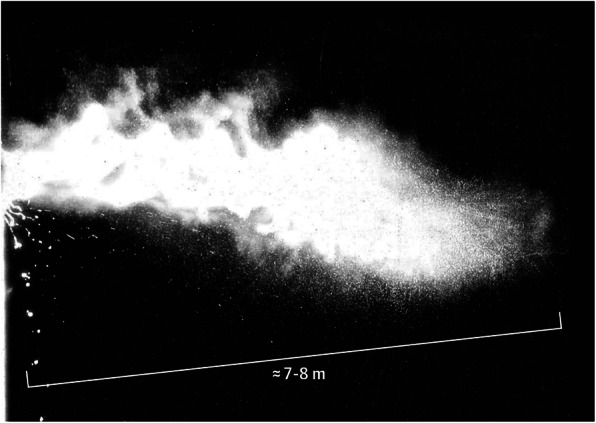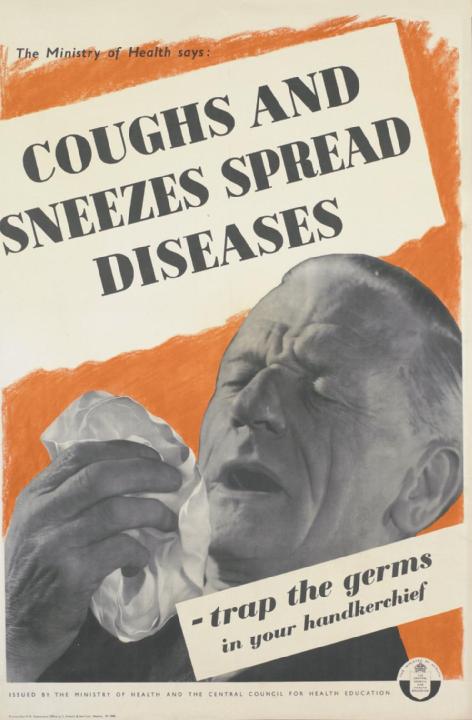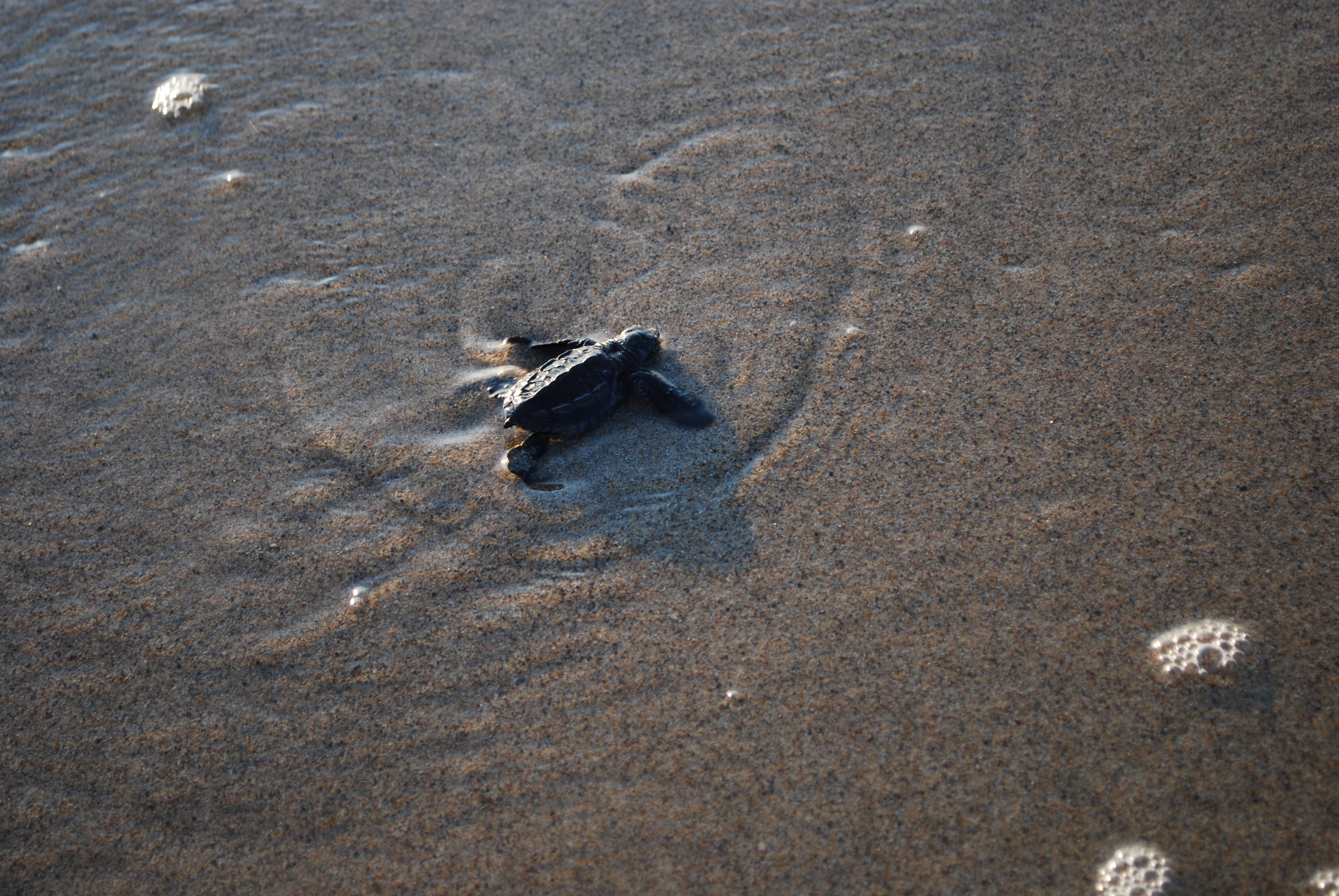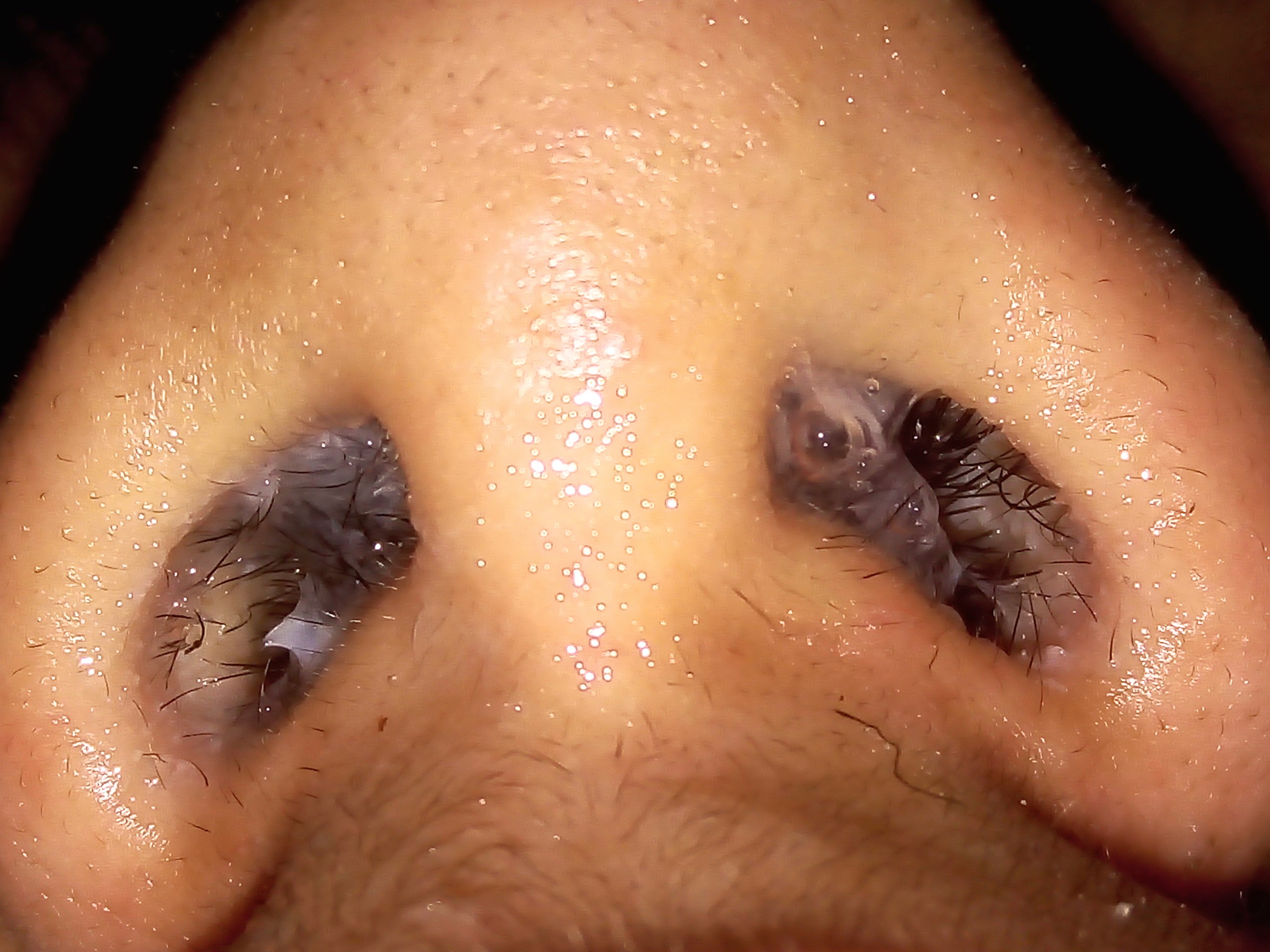|
Sniffle
A sniffle is the instinctive action of inhaling quickly in order to prevent mucus from flowing from one's nasal cavity, as an alternative to blowing the nose. Physiology For a fraction of a second, the performer inhales strongly, pulling mucus from the outer part of the nasal cavity higher up, even into the sinus. This action is generally repeated every few seconds or minutes as the pulled mucus returns to the outer part of the nasal cavity, until the mucus stops returning (due to the mucus having drained into the throat, the nose having been blown to remove the mucus, or some other factor). Sniffling and having a runny nose are not always associated with sneezing or coughing. Sniffling is not necessarily related to illness. In addition to allergies and colds, it can be a result of being in cold temperatures, as a way to hold back tears, and as a tic. When it is related to illness, sniffling can aggravate or extend the illness (relative to not sniffling), by returning to the sin ... [...More Info...] [...Related Items...] OR: [Wikipedia] [Google] [Baidu] |
Blowing The Nose
Nose-blowing is the act of expelling nasal mucus by exhaling forcefully through the nose. This is usually done into a facial tissue or handkerchief, facial tissues being more hygienic as they are disposed of after each use while handkerchiefs are softer and more environmentally-friendly. Nose-blowing may be used to alleviate nasal congestion or rhinorrhea (runny nose) resulting from colds, seasonal allergies, or to expel nasal irritants. Technique The tissue or handkerchief is held gently against the nose. Prior to nose blowing, a deep inhale through the mouth or nose provides the air required to eject the nasal mucus. Exhaling hard through both nostrils at once (or, if only one nostril is congested, just the affected nostril) will effectively eject the mucus. The process may need to be repeated several times to sufficiently clear the entire nose. Health effects While nose-blowing helps to alleviate symptoms of the common cold and hayfever, when it is done excessively or ... [...More Info...] [...Related Items...] OR: [Wikipedia] [Google] [Baidu] |
Sneeze
A sneeze (also known as sternutation) is a semi-autonomous, convulsive expulsion of air from the lungs through the nose and mouth, usually caused by foreign particles irritating the nasal mucosa. A sneeze expels air forcibly from the mouth and nose in an explosive, spasmodic involuntary action. This action allows for mucus to escape through the nasal cavity. Sneezing is possibly linked to sudden exposure to bright light, sudden change (fall) in temperature, breeze of cold air, a particularly full stomach, exposure to allergens, or viral infection. Because sneezes can spread disease through infectious aerosol droplets, it is recommended to cover one's mouth and nose with the forearm, the inside of the elbow, a tissue or a handkerchief while sneezing. In addition to covering the mouth, looking down is also recommended in order to change the direction of the droplets spread and avoid high concentration in the human breathing heights. The function of sneezing is to expel mucus con ... [...More Info...] [...Related Items...] OR: [Wikipedia] [Google] [Baidu] |
Sneeze
A sneeze (also known as sternutation) is a semi-autonomous, convulsive expulsion of air from the lungs through the nose and mouth, usually caused by foreign particles irritating the nasal mucosa. A sneeze expels air forcibly from the mouth and nose in an explosive, spasmodic involuntary action. This action allows for mucus to escape through the nasal cavity. Sneezing is possibly linked to sudden exposure to bright light, sudden change (fall) in temperature, breeze of cold air, a particularly full stomach, exposure to allergens, or viral infection. Because sneezes can spread disease through infectious aerosol droplets, it is recommended to cover one's mouth and nose with the forearm, the inside of the elbow, a tissue or a handkerchief while sneezing. In addition to covering the mouth, looking down is also recommended in order to change the direction of the droplets spread and avoid high concentration in the human breathing heights. The function of sneezing is to expel mucus con ... [...More Info...] [...Related Items...] OR: [Wikipedia] [Google] [Baidu] |
Mucus
Mucus ( ) is a slippery aqueous secretion produced by, and covering, mucous membranes. It is typically produced from cells found in mucous glands, although it may also originate from mixed glands, which contain both serous and mucous cells. It is a viscous colloid containing inorganic salts, antimicrobial enzymes (such as lysozymes), immunoglobulins (especially IgA), and glycoproteins such as lactoferrin and mucins, which are produced by goblet cells in the mucous membranes and submucosal glands. Mucus serves to protect epithelial cells in the linings of the respiratory, digestive, and urogenital systems, and structures in the visual and auditory systems from pathogenic fungi, bacteria and viruses. Most of the mucus in the body is produced in the gastrointestinal tract. Amphibians, fish, snails, slugs, and some other invertebrates also produce external mucus from their epidermis as protection against pathogens, and to help in movement and is also produced in fish to line the ... [...More Info...] [...Related Items...] OR: [Wikipedia] [Google] [Baidu] |
Instinct
Instinct is the inherent inclination of a living organism towards a particular complex behaviour, containing both innate (inborn) and learned elements. The simplest example of an instinctive behaviour is a fixed action pattern (FAP), in which a very short to medium length sequence of actions, without variation, are carried out in response to a corresponding clearly defined stimulus. Any behaviour is instinctive if it is performed without being based upon prior experience (that is, in the absence of learning), and is therefore an expression of innate biological factors. Sea turtles, newly hatched on a beach, will instinctively move toward the ocean. A marsupial climbs into its mother's pouch upon being born. Other examples include animal fighting, animal courtship behaviour, internal escape functions, and the building of nests. Though an instinct is defined by its invariant innate characteristics, details of its performance can be changed by experience; for example, a dog can imp ... [...More Info...] [...Related Items...] OR: [Wikipedia] [Google] [Baidu] |
Facial Tissue
Facial tissue and paper handkerchief refers to a class of soft, absorbent, disposable papers that are suitable for use on the face. They are disposable alternatives for cloth handkerchiefs. The terms are commonly used to refer to the type of paper tissue, usually sold in boxes, that is designed to facilitate the expulsion of nasal mucus from the nose (nose-blowing) although it may refer to other types of facial tissues such as napkins and wipes. Facial tissues are often referred to simply as "tissues", or (in Canada and the United States) by the generic trademark "Kleenex", which popularized the invention and its use outside of Japan. Manufacture Facial tissue and paper handkerchiefs are made from the lowest basis weights tissue paper (14–18 g/m2). The surface is often made smoother by light calendering. These paper types consist usually of 2–3 plies. Because of high quality requirements the base tissue is normally made entirely from pure chemical pulp, but might contain add ... [...More Info...] [...Related Items...] OR: [Wikipedia] [Google] [Baidu] |
Facial Tissue
Facial tissue and paper handkerchief refers to a class of soft, absorbent, disposable papers that are suitable for use on the face. They are disposable alternatives for cloth handkerchiefs. The terms are commonly used to refer to the type of paper tissue, usually sold in boxes, that is designed to facilitate the expulsion of nasal mucus from the nose (nose-blowing) although it may refer to other types of facial tissues such as napkins and wipes. Facial tissues are often referred to simply as "tissues", or (in Canada and the United States) by the generic trademark "Kleenex", which popularized the invention and its use outside of Japan. Manufacture Facial tissue and paper handkerchiefs are made from the lowest basis weights tissue paper (14–18 g/m2). The surface is often made smoother by light calendering. These paper types consist usually of 2–3 plies. Because of high quality requirements the base tissue is normally made entirely from pure chemical pulp, but might contain add ... [...More Info...] [...Related Items...] OR: [Wikipedia] [Google] [Baidu] |
Common Cold
The common cold or the cold is a viral infectious disease of the upper respiratory tract that primarily affects the respiratory mucosa of the nose, throat, sinuses, and larynx. Signs and symptoms may appear fewer than two days after exposure to the virus. These may include coughing, sore throat, runny nose, sneezing, headache, and fever. People usually recover in seven to ten days, but some symptoms may last up to three weeks. Occasionally, those with other health problems may develop pneumonia. Well over 200 virus strains are implicated in causing the common cold, with rhinoviruses, coronaviruses, adenoviruses and enteroviruses being the most common. They spread through the air during close contact with infected people or indirectly through contact with objects in the environment, followed by transfer to the mouth or nose. Risk factors include going to child care facilities, not sleeping well, and psychological stress. The symptoms are mostly due to the body's immune ... [...More Info...] [...Related Items...] OR: [Wikipedia] [Google] [Baidu] |
Rhinorrhea
Rhinorrhea, rhinorrhoea, or informally runny nose is the free discharge of a thin mucus fluid from the nose; it is a common condition. It is a common symptom of allergies ( hay fever) or certain viral infections, such as the common cold or COVID-19. It can be a side effect of crying, exposure to cold temperatures, cocaine abuse, or drug withdrawal, such as from methadone or other opioids. Treatment for rhinorrhea is not usually undertaken, but there are a number of medical treatments and preventive techniques. The term was coined in 1866 from the Ancient Greek, Greek ''rhino-'' ("of the nose") and ''-rhoia'' ("discharge" or "flow"). Signs and symptoms Rhinorrhea is characterized by an excess amount of mucus produced by the mucous membranes that line the nasal cavities. The membranes create mucus faster than it can be processed, causing a backup of mucus in the nasal cavities. As the cavity fills up, it blocks off the air passageway, causing difficulty breathing through the nose. ... [...More Info...] [...Related Items...] OR: [Wikipedia] [Google] [Baidu] |
Misophonia
Misophonia is a disorder of decreased tolerance to specific sounds or their associated stimuli that has been characterized using different language and methodologies. Reactions to trigger sounds range from anger and annoyance to activating a fight-or-flight response. The condition is sometimes called selective sound sensitivity syndrome. Common triggers include oral sounds (e.g. loud breathing, chewing, swallowing), clicking sounds (e.g. keyboard tapping, finger tapping, windshield wipers), and sounds associated with movement (e.g. fidgeting). Hated sounds are often repetitive in nature. Misophonia is not considered a diagnosable condition. It is not classified as an auditory or psychiatric condition, and so is different from phonophobia (fear of sound); there are no standard diagnostic criteria. Proponents suggest misophonia can adversely affect the ability to achieve life goals and to enjoy social situations. As of 2019 there were no evidence-based methods to manage the condit ... [...More Info...] [...Related Items...] OR: [Wikipedia] [Google] [Baidu] |
Common Cold
The common cold or the cold is a viral infectious disease of the upper respiratory tract that primarily affects the respiratory mucosa of the nose, throat, sinuses, and larynx. Signs and symptoms may appear fewer than two days after exposure to the virus. These may include coughing, sore throat, runny nose, sneezing, headache, and fever. People usually recover in seven to ten days, but some symptoms may last up to three weeks. Occasionally, those with other health problems may develop pneumonia. Well over 200 virus strains are implicated in causing the common cold, with rhinoviruses, coronaviruses, adenoviruses and enteroviruses being the most common. They spread through the air during close contact with infected people or indirectly through contact with objects in the environment, followed by transfer to the mouth or nose. Risk factors include going to child care facilities, not sleeping well, and psychological stress. The symptoms are mostly due to the body's immune ... [...More Info...] [...Related Items...] OR: [Wikipedia] [Google] [Baidu] |
Metonymy
Metonymy () is a figure of speech in which a concept is referred to by the name of something closely associated with that thing or concept. Etymology The words ''metonymy'' and ''metonym'' come from grc, μετωνυμία, 'a change of name', from , 'after, post, beyond' and , , a suffix that names figures of speech, from , or , 'name'. Background Metonymy and related figures of speech are common in everyday speech and writing. Synecdoche and metalepsis are considered specific types of metonymy. Polysemy, the capacity for a word or phrase to have multiple meanings, sometimes results from relations of metonymy. Both metonymy and metaphor involve the substitution of one term for another. In metaphor, this substitution is based on some specific analogy between two things, whereas in metonymy the substitution is based on some understood association or contiguity. American literary theorist Kenneth Burke considers metonymy as one of four "master tropes": metaphor, metonymy, ... [...More Info...] [...Related Items...] OR: [Wikipedia] [Google] [Baidu] |










